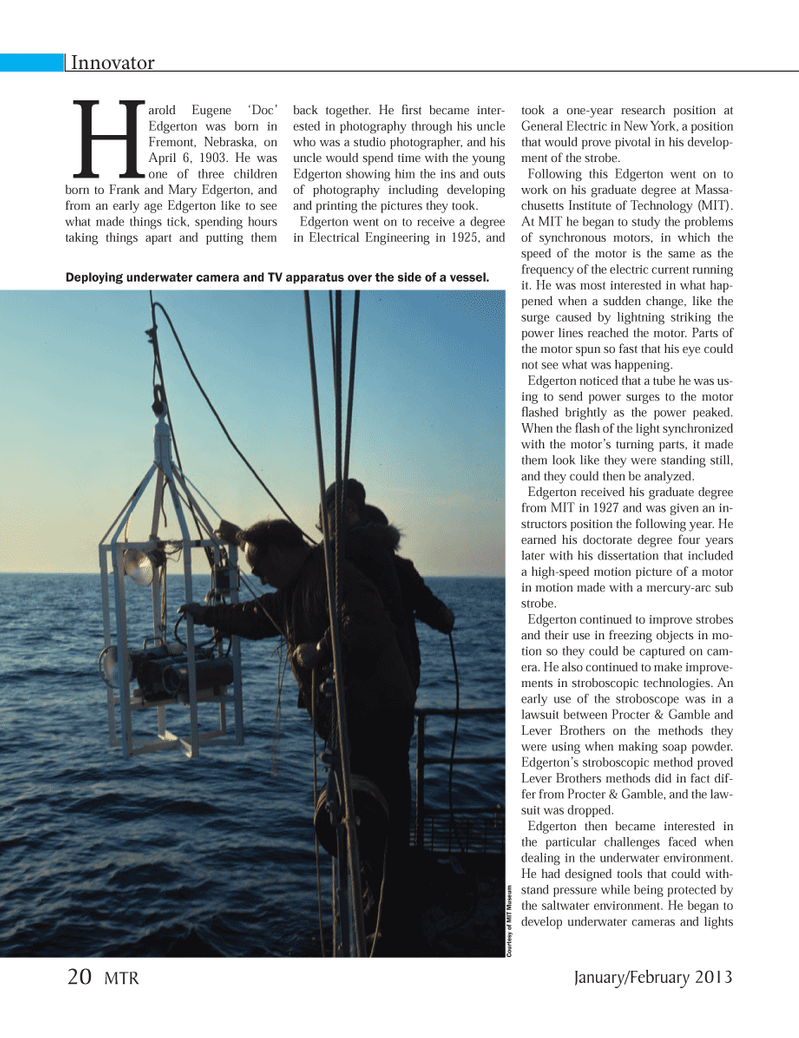
Page 20: of Marine Technology Magazine (January 2013)
Subsea Vehicle Report: Unmanned Underwater System
Read this page in Pdf, Flash or Html5 edition of January 2013 Marine Technology Magazine
Harold Eugene ?Doc? Edgerton was born in Fremont, Nebraska, on April 6, 1903. He was one of three children born to Frank and Mary Edgerton, and from an early age Edgerton like to see what made things tick, spending hours taking things apart and putting them back together. He rst became inter- ested in photography through his uncle who was a studio photographer, and his uncle would spend time with the young Edgerton showing him the ins and outs of photography including developing and printing the pictures they took. Edgerton went on to receive a degree in Electrical Engineering in 1925, and took a one-year research position at General Electric in New York, a position that would prove pivotal in his develop- ment of the strobe. Following this Edgerton went on to work on his graduate degree at Massa- chusetts Institute of Technology (MIT). At MIT he began to study the problems of synchronous motors, in which the speed of the motor is the same as the frequency of the electric current running it. He was most interested in what hap- pened when a sudden change, like the surge caused by lightning striking the power lines reached the motor. Parts of the motor spun so fast that his eye could not see what was happening. Edgerton noticed that a tube he was us- ing to send power surges to the motor ashed brightly as the power peaked. When the ash of the light synchronized with the motor?s turning parts, it made them look like they were standing still, and they could then be analyzed. Edgerton received his graduate degree from MIT in 1927 and was given an in- structors position the following year. He earned his doctorate degree four years later with his dissertation that included a high-speed motion picture of a motor in motion made with a mercury-arc sub strobe. Edgerton continued to improve strobes and their use in freezing objects in mo-tion so they could be captured on cam- era. He also continued to make improve- ments in stroboscopic technologies. An early use of the stroboscope was in a lawsuit between Procter & Gamble and Lever Brothers on the methods they were using when making soap powder. Edgerton?s stroboscopic method proved Lever Brothers methods did in fact dif- fer from Procter & Gamble, and the law- suit was dropped. Edgerton then became interested in the particular challenges faced when dealing in the underwater environment. He had designed tools that could with-stand pressure while being protected by the saltwater environment. He began to develop underwater cameras and lights Innovator Deploying underwater camera and TV apparatus over the side of a vessel. Courtesy of MIT Museum January/February 2013 20 MTRMTR #1 (18-33).indd 20MTR #1 (18-33).indd 201/30/2013 10:14:39 AM1/30/2013 10:14:39 AM

 19
19

 21
21
